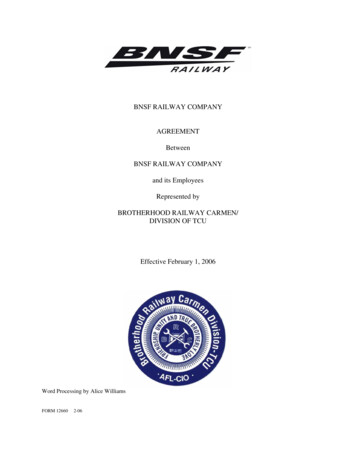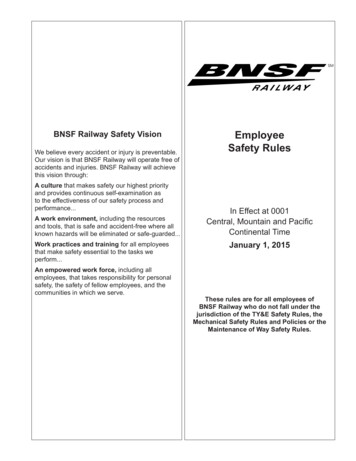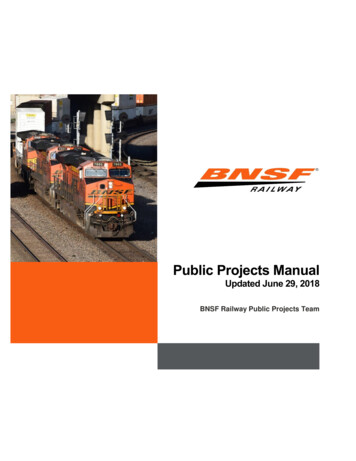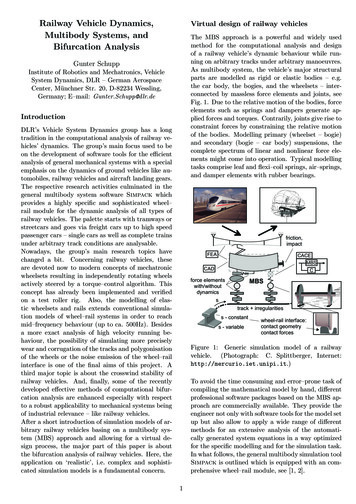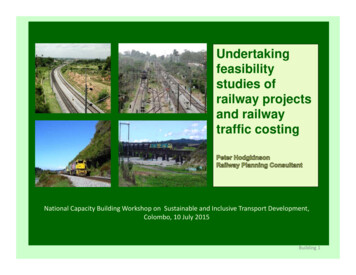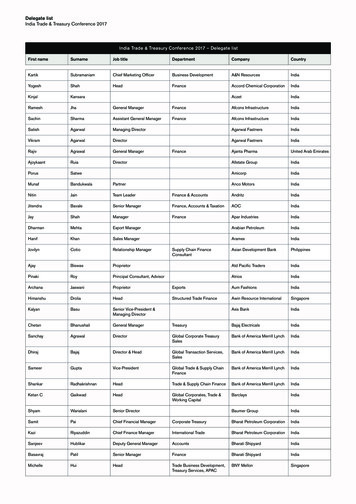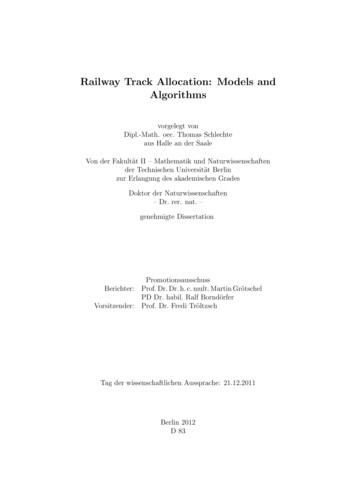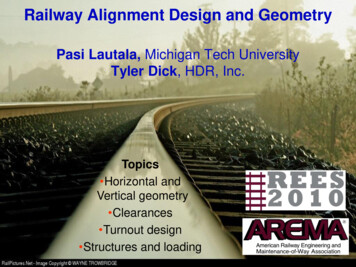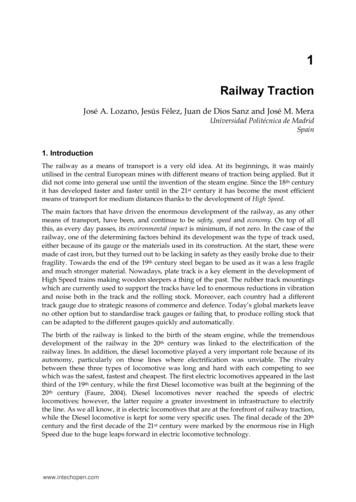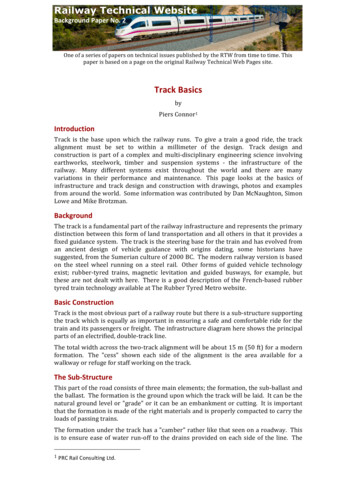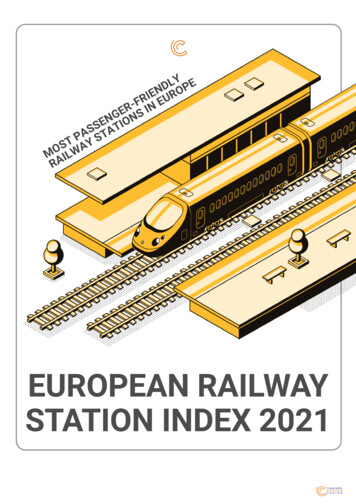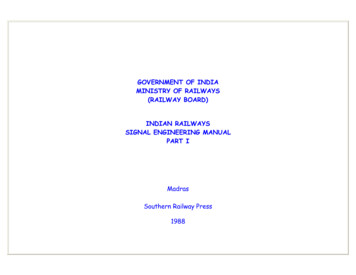
Transcription
GOVERNMENT OF INDIAMINISTRY OF RAILWAYS(RAILWAY BOARD)INDIAN RAILWAYSSIGNAL ENGINEERING MANUALPART IMadrasSouthern Railway Press1988
FOREWORDSignals are the silent sentinels providing safety in train operations. Procedures and practices in their maintenanceand operation are therefore vital to provide the safety as designed.The signaling systems are being continuously updated on the Indian Railways to meet the growing needs of trafficand hence new procedures are being evolved and implemented by supplementary instructions, corrections andmodifications to the Signal Engineering Manual issued in 1955.This revised Manual is an attempt to incorporate all the changes and update the original publication of 1955.I do hope that this will serve to guide and instruct all the officers and staff of the Signaling andTelecommunication Department to discharge their duties effectively and efficiently.Sd. V. C. V. CHENULUNewDelhiMember (Electrical), Railway Board9-1-1988
PREFACESignal Engineering Manual was first issued in January, 1955. Since then much technological development has takenplace in the field of railway signaling. A number of correction memos had to be issued during the last threedecades. 25 kV. A. C. electrification has been taken up on the trunk and other important routes at an acceleratedpace. Special instructions issued regarding signaling on A. C. electrified routes are, therefore, required to beincorporated in the Signal Engineering Manual. The use of electronics in Railway Signaling is increasing day by dayand instructions regarding the same have also to be incorporated. The revision of Signal Engineering Manual had,therefore, become an urgent necessity. Accordingly, it was decided to revise the existing Signal EngineeringManual to make it up-to-date.While revising the Signal Engineering Manual, a critical review was made regarding its organisation and the need tomake it more self-sufficient and functional. It was considered desirable that unnecessary references to variousother texts may be avoided. It was also found necessary to make it into two parts-Part I dealing with items ofgeneral nature, organisation of Signal and Tele communication department, duties and responsibilities of Officersand staff at various levels etc. Part II dealing with specific instructions regarding installation and maintenance ofvarious signaling systems, sub-systems and equipments. Such an arrangement would be found more convenient forreference, by the staff in the field.The work of revision of Signal Engineering Manual was initiated by Shri C. M. Joseph, C. S. T. E. (Retired) in 1980and later taken over by Shri S. Narasimhan, O. S. D./Signal Engineering Manual (C. S. T. E./Southern Railway).Draft Chapters have been thoroughly scrutinised and finalised after discussion with the C.S.T.Es. of all the ZonalRailways. A special sub-Committee consisting of C. S. T. Es. of Southern, Western South Eastern, RailwayElectrification and Director (Tele-communication) R. D. S. O. was appointed to finalise the Chapter on special
requirements for signaling on A. C. electrified routes. Every effort has been made to make the instructionscomprehensive. However, in a work of this type it is not possible to provide for every contingency that may arise inday to day working. C. S. T. Es. of Zonal Railways may, therefore, supplement, where necessary, the practices andprocedures/orders as would suit local circumstances of their Railway. It is needless to point out that suchinstructions would not contravene any provisions of this Manual, the codes of various Departments of the Railwaysthe General Rules or any statutory regulations in force.Provisions in the Signal Engineering Manual will apply to all signaling works to be taken up in future. In theinstallations already existing or in progress, wherever the requirements of this Manual are not complied with,suitable works may be undertaken on a programmed basis to ensure compliance with this Manual.Sd. (O. P. JAIN)New DelhiDate : 9th January, 1988.Executive Director (Signal and Tele communicationRailway Board
Signal Engineering Manual ( Vol-I )CONTENTSChapter IOrganisation of the Signal and Tele communication Department.Chapter IIDuties of Signal and Tele communication Engineers.Chapter IIIDuties of Signal InspectorsChapter IVBudget Estimates, Expenditure and 1 5 Budgetary Control andCompletion Reports.Chapter VPlanning, Estimating and Survey .Chapter VISignaling Stores and their AccountalChapter VIIRequirements of SignalingChapter VIIIDrawings, Specifications and Hooks of reference.Chapter IXGeneral Instructions for Installation of Signaling Equipment.Chapter XContracts for WorksAppendix
CHAPTER IORGANISATION OF THE SIGNAL AND TELECOMMUNICATION DEPARTMENTSECTION ' A'OfficersSignal and Telecommunication Department—An Overview1.1. The efficient upkeep of Signal and Telecommunication assets of the Railways is theresponsibility of the Open Line Organisation of the Signal and Telecommunication EngineeringDepartment. The major construction activities of the Railways may be under the administrativecontrol of a Chief Signal and Telecommunication Engineer (Construction) reporting directly to theGeneral Manager of an Open Line or under the independent administrative control of a ChiefAdministrative Officer (Construction) or General Manager (Construction) reporting directly to theRailway Board.Structure of Open Line Organisation1.2. The Chief Signal and Telecommunication Engineer is the Administrative and Professional Headof the Signal and Telecommunication Department and is responsible to the General Manager forthe efficient and economical working of the Department.1.3. The Chief Signal and Telecommunication Engineer may be assisted in his work by one or more
Chief Signal Engineers and/or Chief Telecommunication Engineers. Wherever provided, the ChiefSignal Engineer and Chief Telecommunication Engineer are in independent charge of theirrespective areas or control. Their work is, however, co-ordinate by the Chief Signal andTelecommunication Engineer who is responsible to the General Manager.1.4.1. The Chief Signal and Telecommunication Engineer as well as the Chief Signal Engineer andthe Chief Telecommunication Engineer, where provided, is assisted at the Headquarters by a teamof Officers who may consist of Deputy Chief Signal and Telecommunication Engineers, SeniorSignal and Telecommunication Engineers and Assistant Signal and Telecommunication Engineers.1.4.2. The Chief Signal and Telecommunication Engineer will lay down the duties of each of theOfficers of the Headquarters Organisation.1.5. The expression " Chief Signal and Telecommunication Engineer " wherever used in this Manualincludes Chief Signal Engineer, Chief Telecommunication Engineer and Chief Signal andTelecommunication Engineer (Construction) unless the contrary is clear from the context.1.6. The Chief Signal and Telecommunication Engineer shall be in charge of staff cadre— gazettedand non-gazetted.Construction Organisation1.7. The Chief Signal and Telecommunication Engineer (Construction) shall provide necessarydirection and control for the efficient and economical execution of all works under his charge.1.8. The Chief Signal and Telecommunication Engineer (Construction) is assisted at theHeadquarters by a team of Officers who may consist of Deputy Chief Signal and
Telecommunication Engineers, Senior Signal and Telecommunication Engineers and Assistant Signaland Telecommunication Engineers,1.9. The Chief Signal and Telecommunication Engineer (Construction) shall maintain liaison with theOpen Line Organisation and shall follow the general policies and procedure laid down for theexecution of works. In cases where a different policy or procedure becomes necessary to befollowed, he shall do so after due consultation with the Open Line Organisation to adopt anaccepted policy or procedure.1.10. The Chief Signal and Telecommunication Engineer (Construction) shall exercise necessarybudgetary control within the allotment of funds at his disposal and shall co-ordinate with the ChiefSignal and Telecommunication Engineer for compilation of budget at every budgetary stage.1.11. The Chief Signal and Telecommunication Engineer (Construction) shall co-ordinate with theChief Signal and Telecommunication Engineer with regards to the placement of personnel for thevarious assignments under his charge keeping in view the overall career development of suchpersonnel.1.12. In the case of certain major joint projects for Survey, or construction, the Signal andTelecommunication unit may be constituted as a self contained unit under the administrativecontrol of the head of the Project. In such cases, the Head of the Signal and TelecommunicationBranch shall be responsible for co-ordination with the Chief Signal and TelecommunicationEngineer as mentioned in paragraphs 1.9 and 1.11.Divisional Officers
1.13. A Signal and Telecommunication Engineer of appropriate grade is in charge of the Signalingand Telecommunication Branch on each Division. He is responsible to the Divisional RailwayManager for the maintenance as well as correct functioning of the installations under his charge.He is under the technical control of the Chief Signal and Telecommunication Engineer to whom heis responsible for all technical matters. He may be assisted by a team of officers of the samegrade or in lower grades. In case more than one officer, in the highest grade is available on aDivision, one of them may be nominated as the coordinating officer. The Chief Signal andTelecommunication Engineer will lay down the duties of the various officers of the Signal andTelecommunication Branch on the Division.1.14. The term "Divisional Signal and Telecommunication Engineer" includes Senior Divisional Signaland Telecommunication Engineer (Junior Administrative Grade) and Divisional Signal andTelecommunication Engineer (Senior Scale) holding charge of a division.Extra Divisional Organisation1.15. The following are the extra Divisional Organisations o f the Signal and TelecommunicationDepartment on the Railways :—(a) Signal and Telecommunication Workshops ;(b) Signal and Telecommunication Training School ;(c) Microwave Organisation ;(d) Field Units of Construction Organisation ;
(e) Any other unit designated by the railway.1.16. Each of these Organisations is under the control of an Officer of appropriate grade who isresponsible for its efficient functioning to the Chief Signal and Telecommunication Engineer/ChiefSignal and Telecommunication Engineers (Construction) directly or through an Officer of theHeadquarters Office in the appropriate grade. The controlling Officer may be assisted by a teamof officers in various grades as required.SECTION 'B'Strength of Officers1.17. Strength of Officers in the Headquarters Office of Chief Signal and TelecommunicationEngineer, Chief Signal and Telecommunication Engineer (Construction), Divisional Offices and inextra divisional organisations shall generally be in accordance with the studies conducted by theEfficiency Beereau of the Railway Beard.SECTION ' C'Technical Staff1.18.1. The following are the technical staff of the Signal and Telecommunication Department forthe purpose of this Manual.(a) Signal Inspectors, artisan staff under their charge(b) Drawing office staff ; and
(c) Supervisory and artisan staff of Signal and Telecommunication Workshop.1. 18.2. The Signal Inspectors are classified as Sectional Signal Inspectors, Senior Signalinspectors, 'Chief Signal Inspectors and Technical Inspectors.1.18.3. The Sectional Signal Inspectors are directly in charge of installation and maintenance ofsignalling on a section.1.18.4. The Senior Signal Inspectors are directly in charge of installation and maintenance of moreimportant sections.1.18.5. The Chief Signal Inspectors supervise the work of one or more Sectional Signal InspectorsSenior Signal Inspectors and are responsible to the Divisional Signal and TelecommunicationEngineer.1.18.6. The Technical Inspectors are headquartered in the Office of the Chief Signal andTelecommunication Engineer/Divisional Signal and Telecommunication Engineer and assist him indischarging his technical duties.1.19. Staff under Inspectors :1 19.1. Each Sectional Signal Inspector shall be assisted by one or more maintainers andmaintenance gangs.1.19.2. Each Sectional/Chief Signal Inspector shall be provided with one or more special gang/gangs for attending to maintenance requirements that may be considered normally beyond the
scope of maintenance.1.19.3. Each Chief Signal Inspector shall be provided with office/stores clerks and stores khalasisdepending on the quantum of office/stores work. Adequate number of chowkidars for guardingrailway material in his custody shall also be provided where necessary.1.19.4. Each Signal Inspector except Technical Inspector may be provided with a trolley or a motortrolley. Adequate number of trolleymen shall also be provided.1.19 5. Each Senior Signal Inspector shall be assisted by appropriate staff as provided for aSectional Signal Inspector.SECTION ' D'Strength, Charges, Designations1.20. Strength and Charges of staff :The strength and charges of Inspectors, Maintainers, Sectional gangs and office staff shall begenerally in accordance with an approved yard stick framed by the Efficiency Bureau of theRailway Board. Where such a yard stick is not available, the Chief Signal and TelecommunicationEngineer shall frame a suitable one with due consideration to the standard of signalling, type ofinstallation, size of yards, density of train services and general importance of the section.1.21. Designation and Code initials :The designations and code initials of Officers, Inspectors and Maintainers shall be as under ::
1.21.1. Officers :(a) Chief Signal and Telecommunication Engineer(b) Chief Signal Engineer(c) Chief Telecommunication EngineerC. S. T. E.C. S. E.C. C. E.(d) Deputy Chief Signal and Telecommunication EngineerDy. C. S. T. E.,(e) Divisional Signal and Telecommunication EngineerD. S. T. E.Note.—If the Divisional Officer is in Junior Administrative Grade, the Prefix Senior (Sr.) is addedto D. S. T. E.(f) Senior Signal and Telecommunication Engineer (in Headquarters and extra divisionalorganisations). S. S. T. E.(g) Assistant Signal and Telecommunication Engineer.S. S. T. E.1.21.2. Inspectors :(a) Chief Signal Inspector(b) Senior Signal InspectorC. S. I.S. S. I.
(c) Sectional Signal InspectorS. I.(d) Technical InspectorT. I.1.21.3. Maintainers(a) Mechanical Signal MaintainersM. S. M.(b) Electrical Signal MaintainerE. S. M.CHAPTER IIDUTIES OF SIGNAL AND TELECOMMUNICATION ENGINEERSSECTION ' A '2.1 Duties of Signal and Telecommunication Engineer in charge of Maintenance or ConstructionThe Signal and Telecommunication Engineer in charge of Maintenance or Construction is generallyresponsible for(a) The installation and maintenance of all signalling and telecommunication equipment under hischarge in a satisfactory and safe condition.(b) Observance of the rules and procedures laid down in the General and Subsidiary Rules, Rulesfor opening of a Railway, the Signal Engineering Manual, the Telecommunication Manual, relevantRule books and Manuals and orders and circulars issued by the Chief Signal and Telecommunication
Engineer from time-to-time and ensuring that all staff under his charge are acquainted withrelevant rules and working methods and efficiently perform their allotted duties.(c) Preparation of plans and estimates and safe execution of works in his charge.(d) Ensuring that all important inspection notes of higher authorities receive prompt action.(e) Co-ordination with Engineering and other branches in case of combined works ; obtainingsanction of Commissioner of Railway Safety for new signalling works or alterations and additions tothe existing signalling installations, either separately for purely signalling works or jointly withother Departmental officers in the case of combined works.(f) Co-ordination with concerned branches in case of accidents for speedy restoration of trafficand for investigation into the causes of accidents.(g) Co-ordination with officers and staff of other branches in all other matters to ensure smoothfunctioning of signalling and telecommunication system.(h) Ensuring supply of approved quality materials and tools for the installation and maintenance ofthe equipment.(i) Control over expenditure in relation to budget allotments and sanctioned estimates.(j) Submission of proposals for Revenue and Works Budget, and for periodic reviews.(k) Exercise of such powers as may be delegated to him in Establishment and other matters.
(1) Ensuring strict discipline amongst his staff within the frame work of the Rules.(m) Dealing promptly with appeals and representations from and looking after the welfare of hisstaff.(n) Issue of special and specific maintenance schedules for Inspectors and Maintainers as andwhen necessary.2.2. Transfer of Charge :2. 2. J. Instructions on "Transfer of Charge" are contained in Chapter I of Indian Railway Code forEngineering Department.2.2.2. The Divisional/Senior Signal and Telecommunication Engineers handing over and taking overcharge of a Division or of a work shall carry out joint inspection of such works or importantsections as necessary.2.2.3. The "Transfer of Charge" statement shall be prepared in adequate number of copies, signedby both and one copy sent to the Chief Signal and Telecommunication Engineer2.3. Applicability to other Signal and Telecommunication EngineersThese instructions with suitable modifications will apply to the other Signal and TelecommunicationEngineers posted to a Division or for executions of works.SECTION ' B '
Additional duties of Signal and Telecommunication Engineer in charge of Maintenance2.4. The Divisional Signal and Telecommunication Engineer is generally responsible for :(a) Ensuring that no alteration to an installation is made, which is a deviation from the originalapproved plan diagram or specification, without the authority of the Chief Signal andTelecommunication Engineer.(b) Periodical inspection of all Signalling and Telecommunication installations under his charge by aSignal Engineer, at least once in twelve months. The inspection shall be intensive with reference tothe prescribed schedule of maintenance. A monthly report of inspections so made shall besubmitted to the Headquarters Office.(c) Inspection of Signals within his jurisdiction from footplate of a locomotive or a driving cabboth by day and by night in both Up and Down direction once in a year, preferably jointly withofficers of Mechanical /Electrical /Traffic branches.(d) Having in his possession the under mentioned drawings and registers as required when calledupon to accompany the inspection of superior officers like Divisional Railway Manager, Chief Signaland Tele-communication Engineer", General Manager, Commissioner of Railway Safety or an officerof the Railway Beard etc.(i) Interlocking plans of the section ;(ii) Foot plate/station inspection details ;(iii) Previous inspection reports of the section by Chief Signal and Telecommunication Engineer.
General Manager, Commissioner of Railway Safety etc.,(iv) Any other books/papers/documents as per instructions issued by the Headquarters office ofthe Zonal Railway.(c) Inspection of office and stores of Inspectors once in a year. During the inspection apercentage check of some of the stores items, particularly those that are costly shall be made.(f) Keeping watch on inspection of Signal and Telecommunication installations and foot plateinspection by the Inspectors under his control.(g) Analysing the failures from the reports submitted by the inspectors and taking remedialmeasures to eliminate recurrence of failures. The reports may be examined in a meetingpreferably jointly with all Chief Signal Inspectors of the division to improve the standard ofmaintenance.Note.—Each Divisional Signal and Telecommunication Engineer must maintain a record showing thenumber of failures and number of trains detained every month over the jurisdiction of eachInspector.(h) Drawing out a programme of overhauling and/or testing of interlocking frames, interlocking keyboxes, Station Master's slide control frames, block instruments, relays, cables, point and signalmachines, etc., as per instructions contained in Chapter XIII.(i) Reviewing the position in regard to supply of stores on the Division periodically.
(j) Planning replacements of wornout installations and additional signalling inputs necessary toimprove the working and submission of proposals for the same.(k) (i) Reviewing the staff position periodically to ensure that the strength is neither in excess norshort of requirements.(ii) Arranging to obtain timely sanction for additional maintenance staff before new works oradditions/alterations to existing installations involving increased workload are commissioned.(l) Ensuring sending periodical returns to Headquarters Office as well as replies to letters fromHeadquarters within the time specified.Note.—The rules in Section' B 'will also apply to a Senior Signal and Telecommunication Engineernormally in charge of Construction, who is entrusted with the maintenance of any installation asfor the time being.SECTION CAdditional duties of Signal and Telecommunication Engineer in charge of Construction2.5. The Signal and Telecommunication Engineer in charge of Construction is responsible for(a) the accuracy, quality and progress of the works entrusted to him and for ensuring that "eachwork is efficiently organised and so programmed that it progresses speedily and is completedwithin the time specified.(b) ensuring that all works are carried out strictly in accordance with the approved plans.,
standard drawings and specifications and conforming to the provisions of this Manual. Deviations,if any, shall have the prior approval of the Chief Signal and Telecommunication Engineer.(c) (i) ensuring that traffic notices are issued in consultation with other Divisional officers beforeany existing installation is altered or any new installation is introduced which affects the safeworking of any signal, points or interlocking :(ii) ensuring issue of temporary working instructions for working of traffic, where necessary.(d) Furnishing relevant information to the Operating department to help them in the preparationof working Rules and temporary working instructions.(e) Arranging for obtaining the sanction of Commissioner of Railway Safety where required as perinstructions' in paragraphs 9. 6 and 9.7.(f) Advising Commissioner of Railway Safety by a message after bringing a new installation ormodification to the existing installation into use and submission of a Safety Certificate as perinstructions in Paragraph 9.8.(g) Submitting progress reports on Form S. & T./PR1 (Annexure ' 1 ') to Headquarters everymonth.(h) Periodical verification of the Materials-at-site as per Paragraph 6.14.Note,.—The rules in Section ' C' will also apply to a Divisional Signal and Telecommunication
Engineer normally in change of maintenance, who is entrusted with the execution of certainspecific works.CHAPTER IVBUDGET ESTIMATES, EXPENDITURE AND BUDGETARY CONTROL ANDCOMPLETION REPORTSSECTION 'A'Introduction4.1. Budget Terms4.1.1. Budget Estimates.—Every Railway Administration has to prepare estimates of expenditureexpected to be incurred by it in a year and submit them on prescribed dates well in advance of thebeginning of that year to the Railway Board for obtaining the sanction of the Parliament or thePresident. Such estimates are called '" Budget Estimates ".4.1.2. Demands for Grants.—On the basis of the Budget Estimates received from the variousRailway Administrations and other spending units, the Railway Board prepare their " Demand forGrants " and present them to the Parliament or the President, as the case may be, for sanction.4.1.3. Grants and Appropriations.—The ' Demands for Grants ' as finally approved by theParliament are called the Budget ' Grants ' and those sanctioned by the President withoutreference to the Parliament are called ' Appropriations '.
4.1.4. (i) Budget Orders and Allotments.—The Railway Grants and Appropriations for a year aredistributed by the Railway Board to the various Railway Administrations and other spending unitsdirectly under the Railway Board through what are known as ' Budget Orders'. The Budget Ordersare accompanied by the Budget Documents.(ii) The Grants and Appropriations distributed to the various Divisions and spending units arecalled Budget ' Allotments '.4.1.5. Budget Documents.—The complete Budget, is printed in the form of books as under :—(i) Demands for Grants ;(ii) Explanatory Memorandum showing the financial results of the year ;(iii) Works, Machinery and Rolling Stock Programme of Railways.4.1.6. Re-appropriation.—The transfer of funds originally assigned for expenditure on a specificobject to supplement the funds sanctioned for another object is called " Re-appropriation ". Thepowers of the Railway Board and Railway Administration in respect of re-appropriation aredetailed in Chapter III of the Indian Railway Financial Code Volume I (extracts at Annexure ' 11').4.1.7. Review of Expenditure.—The sufficiency or otherwise of the sanctioned budgetallotments shall be reviewed periodically by each Railway Administration on the basis ofexpenditure actually incurred upto the time of review and the anticipated expenditure during theremaining portion of the financial year. The detailed procedure in regard to review of Expenditure
is contained in Chapter III of the Indian Railway Financial Code, Volume I (extracts at Annexure '12 ').4.2. Demands for Grants.—All revenue working expenses of the Railway are classified under 13sub major heads with separate abstract for each sub major head. The sub major heads are dividedinto minor, sub and detailed heads as detailed in Volume II of the Indian Railway Financial Code(Minor, sub and detailed heads, relevant to Signalling and Telecommunication are at Annexure ' 13')4.3. Revenue and Works Budgets.—Budget estimates of the Signal and TelecommunicationDepartment comprise mainly of the following :—(i) Estimates of Working Expenses.—These are based on the Working Expenses for the repairsand maintenance of Signaling, interlocking and Telecommunication Services and comprise estimatesof expenditure against Demand Nos. 3, 7 and 8 referred to in para 4.2.(ii) Works Budget.— Open Line Works Budget' otherwise known as ' Annual Works Programme 'comprises estimates of requirements for Works against Demand No. 16.(iii) Plant and Machinery Programme comprises estimates of requirements for Machinery and Plantagainst Demand No. 16.SECTION ' B 'Estimates for Working Expenses or Revenue Budget
4.4. Compilation4.4.1. The Revenue Budget or Estimate of Working Expenses is compiled in the prescribed forms inthe Headquarters Office on the basis of proposals submitted by the Divisions/Extra DivisionalUnits in accordance with instructions contained in Chapter III of the Indian Railway FinancialCode. Volume I (extracts at Annexure ' 14 ')SECTION ' C'Works, Machinery and Rolling Stock Budget4.5. Detailed instructions for preparation and submission of Works, Machinery and Rolling StockBudget are contained in Chapter III of Indian Railway Financial Code, Volume I (extracts atAnnexure' 15 '). The classification of expenditure by primary units of expenditure are contained inVolume II of the Financial Code (Heads relevant to Signal and Telecommunication Department atAnnexure ' 16 ').4.6. Compilation of Plant and Machinery Programme—4.6.1. The detailed instructions for the preparation and submission of the Plant and MachineryProgramme are contained in Chapter XV of the Indian Railway Code for the MechanicalDepartment (Workshops).4.6.2. The requirements of machinery in Signalling and Telecommunication Workshops shall becollected and shown in Plant and Machinery Programme. The description of machinery, number,allocation, cost etc., shall be shown on the prescribed forms and submitted along with theprogramme. This programme is submitted 15 months in advance of the financial year.
SECTION 'D'Administering the Budget4.7. Detailed instructions for administering the Budget are contained in Chapter III of the IndianRailway Financial Code (extracts at Annexure ' 17 ').SECTION ' E'Maintenance of Accounts4.8. Code Rules.—Rules in regard to the maintenance of Open Line accounts are contained inChapter XIV of the Indian Railway Code for the Engineering Department.4.9. Accounting4.9.1. The expenditure incurred is brought to account through various vouchers. Subject to suchpowers as may be delegated to him, the Divisional Signal and Telecommunication Engineer mayincur expenditure on all ordinary maintenance works and establishments upto the limits of theprovision in the Revenue Budget Estimates, sanctioned for his unit for the year.4.9.2. All vouchers, such as debit notes for stores supplied, freight bills shall be carefullyscrutinised before acceptance as to the reasonableness and propriety of the debits raised.Wherever necessary, such debits shall be correlated and checked with the initial records in theoffice, such as indents and work orders on Workshops, and necessary endorsements made thereon.4.10. Departmental Registers on Extra-Divisional Units
4.10.1. Revenue Allocation Register.—The Divisional Signal and Telecommunication Engineer incharge of an Extra-Divisional Unit shall maintain a Register of Revenue expenditure, if any,incurred by him under the relevant grants in order to keep himself acquainted with the progressof expenditure in his unit as compared with the sanction in the Authorisation Rolls. The detailedinstructions in regard to the maintenance of Revenue Allocation Register are contained in Para1469 of Engineerin
PREFACE Signal Engineering Manual was first issued in January, 1955. Since then much technological development has taken place in the field of railway signaling.
